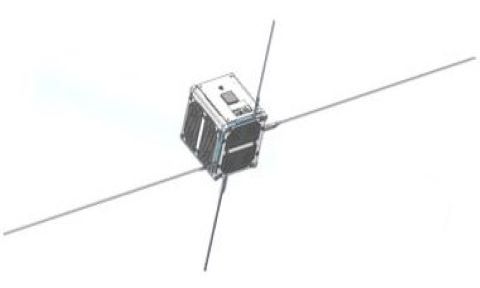VELOX-P Pico-satellite
VELOX-PII is the first Singapore picosatellite to operate in low Earth’s orbit. It is developed under the Nanyang Technological University’s Undergraduate Satellite Program, which provides an opportunity for students to participate in a multidisciplinary hands-on space project.
The objective is to train engineers to support the Singapore space industry. Besides educational objective, VELOX-PII also contributes as a technology demonstration platform and a design validation for NTU future satellite missions such as VELOX-I and VELOX-II. The picosatellite is used to qualify several in-house built hardware and software such as the fault tolerant power system, attitude determination & control algorithms, fine sun sensor, solar panel etc.

| Dimension | 100 x 100 x 113.5 mm |
| Mass | 1330 grams |
| Expected lifetime | 12 months |
| Orbit | Sun-synchronous LEO, altitude 650 – 700 km |
| Attitude determination and control system | 3-axis stabilized: 1 GPS receiver, 2 IMUs, 1 dual-FOV sun sensor, 5 coarse sun sensors, and 3 magnetic torquers |
| On-board data handling | 100MHz 8051 MCU, 2Gb SD card, UART and I2C data interfaces |
| Communications | 9600bps BPSK downlink / 1200bps AFSK uplink, UHF & VHF dipoles |
| Power subsystem | 5 GaAs panels for 2.4W peak, 2600mAh Li-ion battery |
| Structure | Hard anodized Al. 7075 chassis, with stainless steel load bearing parts |
| Thermal control | Battery heaters |
| Experiment | Technology demonstration platform, new dual-FOV sun sensor, fault tolerant power management system, ADCS |
| Ground segment | Ground station in NTU with UHF/VHF high-gain cross Yagi-Uda antennas |
STATUS
The satellite team has completed the development of two flight models (VELOX-PI and VELOX-PII) in August 2012. After a launch delay, VELOX-PII was successfully lifted off on board Russia’s RS-20B rocket (Dnepr) at 3:10pm, Singapore time (7:10am Co-ordinated Universal Time, UTC) on Thursday, 21 November 2013. In the first ground pass at 22:41pm Singapore time, the satellite team has successfully established contact to the satellite. In the second pass at 00:18am on 22 November 2013, the team has successfully communicated to the satellite and downloaded the house-keeping data. The information indicates that the satellite’s battery is fully charged and the temperature of the satellite is in the range of 20-40 degree C.
The satellite has been performing well in space since the initial ground contact. After the LEOP (launch and early operation), the VELOX satellite team has performed various experiments on the satellite. Initial experiment includes downloading the whole
orbit data to study the various satellite status. The satellite is designed to store its operating status of various subsystems right from the very first orbit and the ground station can command the satellite to download any orbital data subjected
to the downlink bandwidth. Attitude control and navigation experiments have also been conducted to evaluate the performance of the sun sensor in space as well as the orbit propagator accuracy. The satellite is also capable of performing “batteryless”
operation when the battery degraded, i.e. the satellite can operate by using only the solar energy. The satellite has been operating in space for more than 5 months and the hardware of the satellite remains healthy.





CW beacon
Speed: 6 dots/second
Interval: LEOP-60 seconds NOP-120 seconds
AX.25 packet
Modulation: BPSK
Authorization: Required
Predicted TLE
VELOX-PII
1 39438U 13066Y 13344.41289890 .00002141 00000-0 31424-3 0 119
2 39438 97.7966 56.3541 0075957 133.0448 227.7173 14.74581073 2802
We would like to thank the HAM stations helping us to track the Velox-PII:
| Name | Callsign | Location | Date Time (UTC) | Beacon RX |
|---|---|---|---|
| Mike Rupprecht | DK3WN | JN49lr | 02-Dec-2013 21:16 | VELOXP GZ8D8CGD22222 02-Dec-2013 21:17 | VELOXP GZ8D8CGD22222 02-Dec-2013 21:18 | VELOXP GZ8D8CGD22222 02-Dec-2013 21:19 | VELO4P GZQD8CGD22222 02-Dec-2013 21:20 | VELOXP GZQD8CGD22222 02-Dec-2013 21:21 | VELOXP GZQD8CGD22222 02-Dec-2013 21:22 | VELOXP GZQDQCGDF22FF 02-Dec-2013 21:23 | VELOXP GZQDQCPDF2FFF 02-Dec-2013 21:24 | VELOXP GZQDQCGDF22FF |

